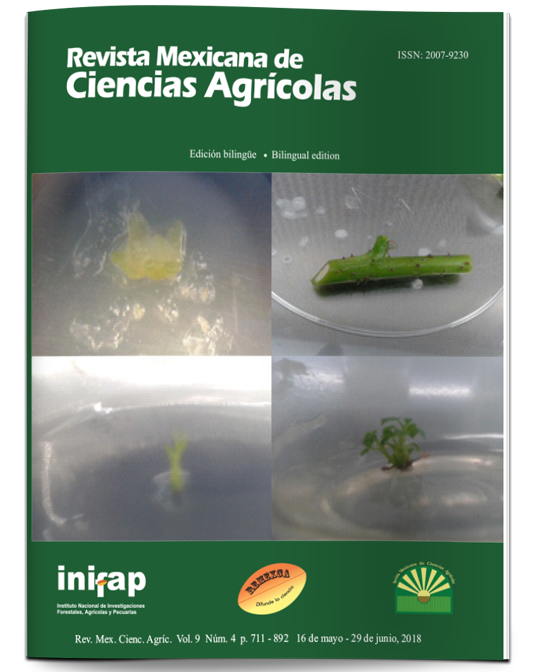In vitro establishment of two cultivars released from strawberries: strawberry and raspberry
DOI:
https://doi.org/10.29312/remexca.v9i4.1397Keywords:
berries, 6-benzylaminopurine, meristems, micropropagation, thidiazuronAbstract
The development of protocols for the production of healthy plants in vitro is important to satisfy the growing demand for strawberries in northern Mexico as an alternative to traditional fruit trees such as walnut and apple trees. In vitro strawberry and raspberry establishment techniques were evaluated from meristematic explants, apices and internodes. A convective disinfection method was used, where disinfecting agents were used as a 70% ethanolic solution, then they were immersed in a 3% commercial solution solution of sodium hypochlorite: water (1:6), for 15 min. Finally, in 0.05% timerosal® solution for 15 min. Apices were evaluated in the case of strawberry apices, and meristems and internodes in the raspberry. For the establishment, Murashige and Skoog salts added with cytokinin 6-benzylaminopurine (BAP), gibberellic acid (GA) and indole butyric acid (AIB) in different concentrations were used for the strawberry case. In raspberry, MS salts added with BAP, thidiazuron (TDZ), GA and AIB were used. The percentages of establishment, necrosis and contamination were evaluated in both cases. The planting of apices in the case of strawberry and its disinfection system, allowed its establishment in vitro, the variables were analyzed by nonparametric tests showed that the best treatment was TT1 with 70% effectiveness. For raspberries, the case of internodes was better during establishment than in the case of meristems, and the best treatment was TT4, with BAP + GA without auxin, with 57% effectiveness.
Downloads
Downloads
Published
How to Cite
Issue
Section
License
The authors who publish in Revista Mexicana de Ciencias Agrícolas accept the following conditions:
In accordance with copyright laws, Revista Mexicana de Ciencias Agrícolas recognizes and respects the authors’ moral right and ownership of property rights which will be transferred to the journal for dissemination in open access. Invariably, all the authors have to sign a letter of transfer of property rights and of originality of the article to Instituto Nacional de Investigaciones Forestales, Agrícolas y Pecuarias (INIFAP) [National Institute of Forestry, Agricultural and Livestock Research]. The author(s) must pay a fee for the reception of articles before proceeding to editorial review.
All the texts published by Revista Mexicana de Ciencias Agrícolas —with no exception— are distributed under a Creative Commons License Attribution-NonCommercial 4.0 International (CC BY-NC 4.0), which allows third parties to use the publication as long as the work’s authorship and its first publication in this journal are mentioned.
The author(s) can enter into independent and additional contractual agreements for the nonexclusive distribution of the version of the article published in Revista Mexicana de Ciencias Agrícolas (for example include it into an institutional repository or publish it in a book) as long as it is clearly and explicitly indicated that the work was published for the first time in Revista Mexicana de Ciencias Agrícolas.
For all the above, the authors shall send the Letter-transfer of Property Rights for the first publication duly filled in and signed by the author(s). This form must be sent as a PDF file to: revista_atm@yahoo.com.mx; cienciasagricola@inifap.gob.mx; remexca2017@gmail.
This work is licensed under a Creative Commons Attribution-Noncommercial 4.0 International license.



